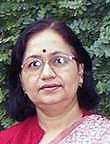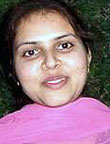Introduction
India has a tribal population of over 84 million which constitutes 8.2% of its total population, according to the Census of India, 20011. Several research studies on various tribal populations living in different parts of India have found them to be socially and economically disadvantaged2,3 and their diets to be nutritionally deficient4-13.
The Oraons are an agricultural tribe found mainly in Orissa, Bihar, Jharkhand and West Bengal (Fig 1). It is believed that the British brought the Oraons to West Bengal from Bihar and Orissa to work in the tea gardens. They are the most prominent tribe of New Mal, which lies under the Jalpaiguri district of West Bengal (Fig 1), where they still work in the tea gardens. The district of Jalpaiguri has 284 tea gardens. The workers in these tea gardens are mostly tribals. At the sub-district level of New Mal, there are 15 tea gardens. Oraons are the major tribe working in these.
Each tea garden is covered by the Integrated Child Development Scheme (ICDS) of the Government of India, which is concerned with the health, nutrition and development of children and their mothers. Each tea garden has similar facilities, such as a health centre, a primary school for children of the workers, and housing provided by the tea garden owners. The tea gardens form natural groupings or clusters and each is mutually exclusive, collectively exhaustive and a small-scale version of the total population.
Despite being covered by the ICDS, the Oraons do not appear to have been studied systematically with regard to diet and traditions.
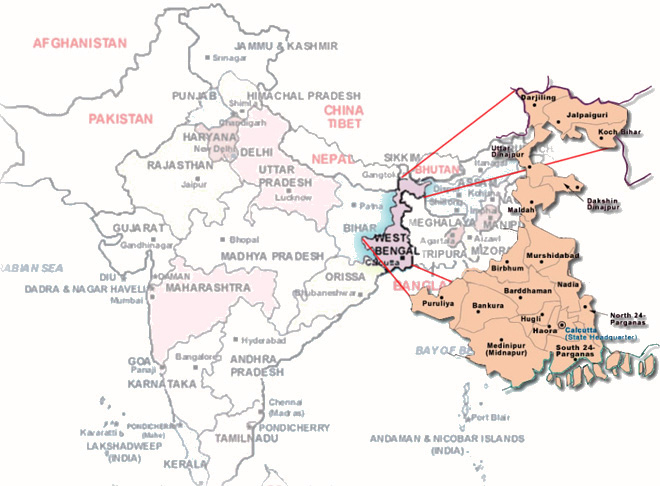
Figure 1: Map showing the geographical distribution of the Oraon tribe.
Methods
The teagardens were categorized into A, B, C and D grades, based on their size. It was felt that extensive data collection within a cluster would permit efficient utilization of time and cost. The present study was undertaken between June 2003 and January 2004 on one of the B-sized tea gardens of New Mal.
In this tea garden there were 300 Oraon households which made up the sampling frame. Households with no member working in the tea garden were excluded, so the final sample consisted of 200 households. In most of these households, both husband and wife were working in the tea garden. All had similar incomes, daily routines and activity levels. Nineteen women who were not available or did not work on the tea garden during the study period, seven pregnant women and 24 lactating women were excluded from the study, in order to maintain uniformity of physiological state and nutrient requirements. Thus, the final data were obtained from 200 males and 150 females aged 20-45 years, and 150 children aged 6-12 years. All children attended the local Baintgoorie primary school.
All subjects were surveyed for their dietary intake and anthropometry. The practices of adults regarding hygiene, medication and addictive substances were also recorded. The data were collected and recorded by one of the investigators (SS) because the subjects were illiterate. A pre-tested questionnaire was used. The data on dietary intakes of children were obtained from their mothers and the child's age was as recorded in the school records. The questionnaire was divided into five sections: family and general demographic information; anthropometric information; dietary intakes; other food-related practices; and health-related knowledge and practice. The children's anthropometric data were collected with the cooperation of the school authorities and the teacher at the primary school.
Height and weight were measured following standard procedures, using a metal tape and a setsquare for height and bathroom scales for weight. Body mass index (BMI) was computed from these data, using the formula BMI = weight (kg)/[height (m)]2. The adults were categorized on the basis of their BMI into CED (chronic energy deficiency) grade III (severe), CED grade II (moderate), CED grade I (mild), low weight normal, normal BMI, and obese grade I, as described by other investigators11,12. Children were categorized as severe, moderate and mild to normal undernutrition, overweight and obese on the basis of their BMI, as described by Shils et al.14.
For assessment of dietary intake, the 24 hour recall method was used. The reliability of this method was improved by using semi-quantitative food frequency questionnaire methodology15 to quantify the intakes of common items and to minimize common sources of error. The staple cereals consumed in this geographical area are rice, eaten boiled, or wheat, consumed in the form of chapattis, which are homemade unleavened bread, made of whole-wheat flour. The size of these varied from household to household. The variability in the size of this food item introduces a major source of error in diet surveys. Hence, each respondent was shown samples of various sizes, and intakes were assessed accordingly. These breads are consumed with dals (legumes), curries and vegetables. The quantities of these were assessed by asking respondents to choose from three standard sized bowls. Similarly, respondents chose glasses and standard serving spoons that corresponded best to their estimated intakes of rice, beverages and other foods. This procedure helped in minimizing the errors due to variability in household-to-household food portions. Energy intakes were calculated from these portions using appropriate food tables16and compared with recommended dietary allowances (RDA) as described by the Indian Council for Medical Research (ICMR)17. Group means were computed and standard deviation calculated after checking the data for normal distribution. Differences between groups were examined for statistical significance using the Student's t-test, and significance tested at p <0.05.
Results
Demography
The adult Oraons in this study all worked 8 hours a day. The work involved the moderate activity of standing and plucking tealeaves. They were paid according to the quantity of leaves plucked. Each worker earned approximately Rs. 800 per month. Most families were nuclear. The adults were all illiterate. They were all converted Christians. No data were collected to formally assess the status of females but they participated in discussions and did not appear oppressed by their husbands. This may have been because they were earning members of the household.
The houses were made of bamboo strips with roofs of asbestos. There was a 12 hour electricity supply. The health center had one doctor, a dispenser (compounder) and two nurses, and facilities for vaccinations, contraceptive information, care of pregnant women, and for treatment of routine illnesses. Open wells were used for water supply and the area surrounding the well was not clean. The village area was contaminated by refuse and decaying garbage, which was a breeding ground for mosquitoes and flies. However, the homes were clean inside. A midday meal was provided in the primary school. Children attending school received khichdi, prepared by boiling rice and legumes together. The energy contributed by this was taken into account when calculating the total energy intake of the children.
Food intake and diet related practices
All Oraons were non-vegetarians. They consumed pork, rat meat, beef and various birds. However, the use of non-vegetarian items was limited to two or three times a month, usually on days when they were paid for their work.
Mean intake of various food groups consumed by the Oraon men, women and children are given, along with comparisons with ICMR RDI for moderately active groups17(Table 1). The intake of non-vegetarian foods was combined with the intake of pulses, because both constitute the major sources of protein in their diet. The table shows that the intakes of all groups are deficient in all food groups to a similar extent. The deficit of pulses and flesh foods was most severe in the diet of the Oraon women. The midday meal program at the local primary school, where khichdi, made from lentil and rice, was distributed to the schoolchildren constituted approximately 50% of the total calorie intake of these children. Yet, the energy intake of the children remained at 52% of ICMR recommended allowances. The consumption of green leafy vegetables was also very deficient, and it consisted mostly of little known locally available greens. One such vegetable was dheki saag, a type of fern, which some grew, along with roots and tubers in their kitchen gardens. Large deficits in intake of protective foods such as milk, vegetables including green leafy vegetables, and fruit were found. They could not provide information about their fruit consumption. Further questioning revealed that they did not spend money to purchase fruit, but consume what is locally available on the trees. It was not possible to quantify this because it varied with seasonal availability. It is noteworthy that these figures do not include vegetable and fruit obtained from their kitchen gardens and locally growing trees.
Table 1: Mean intake of various food groups consumed by Oraon men, women and children compared with ICMR recommended dietary intakes
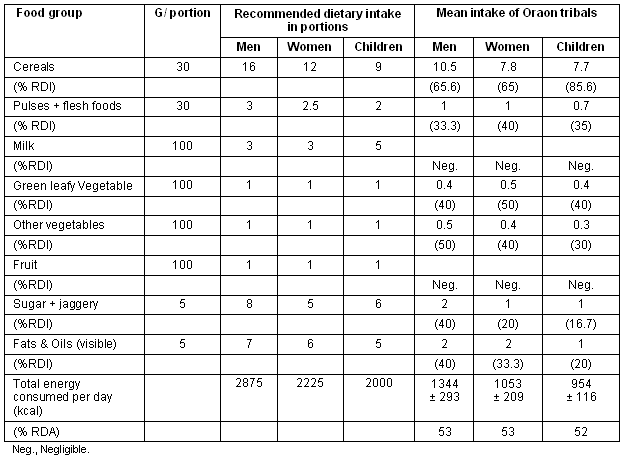
Milk and milk products were almost missing in the diet of all age groups. In the entire village, only 10-14 liters of milk was consumed. They took black tea with salt (without milk and sugar) in the morning. They fermented their leftover rice baasi bhaat. Water drained out of this was drunk and the rice eaten. Their most prevalent methods of cooking consisted of boiling and roasting. For separating the fat from pork, they added a tomato, partially cut into four pieces so that the pieces remain attached to each other, to the meat preparation while it was being cooked.
Nutritional status
The height, weight and computed BMI of the Oraon men, women and children are presented (Table 2).
By general appearance, Oraon men and women were assessed as short statured. The mean BMI of both adult men and women fell in the normal range, despite energy intakes in the order of 52-53% of ICMR RDA. The mean BMI of men was statistically significantly lower than that of the women. The children had a much lower BMI, even though energy intakes of all three groups were similar.
To further assess nutritional status of the groups under study, Oraon men and women were distributed into various categories of chronic energy deficiency (CED) based on their BMI, as described by James and co-workers18for adults (Table 3).
BMI is also found to be useful for assessment of nutritional status of children, especially where reliable records of age are not available19. Age records for these children were obtained from school registers, but their reliability was not established. Hence, classification according to BMI was preferable for this sample of children. In Table 4, the BMI of Oraon children have been distributed in various categories of CED. Ninety percent of the Oraon children aged 6-12 years were undernourished. Ideal BMI for this age group is 18.514.
Table 2: Mean height, weight and body mass index of Oraon men, women and children

Table 3: Distribution of Oraon men and women according to body mass index
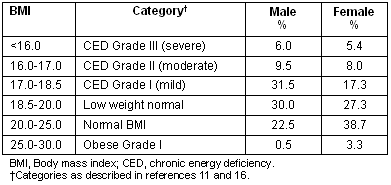
Table 4: Distribution according to body mass index of Oraon children aged 6-12 years
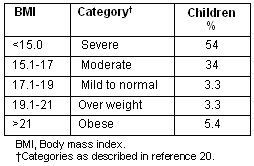
Some data were also obtained on their general appearance and it was found that 14.7% of them appeared very sickly, while only 32% appeared normal. The remainder appeared weak. Six children had a problem with bleeding from the gums, which may have been due to a nutritional deficiency or poor oral hygiene, and five children had dyspigmented hair, which is suggestive of protein-calorie malnutrition20.
Other traditions and practices
In addition to food, a fermented drink called hadiya was popular. Hadiya was prepared on a commercial level using rice fermented with 3-4 tablets of ranoodava. Ranoodava were large, round-shaped tablets of approximately 4 cm diameter made by mixing several herbal leaves, naag bel, junglepari, chittbel, Masalapattai, Paharpari and dadhfunda in certain proportions. To make hadiya, rice is half boiled, spread on a plain surface to remove extra water and mixed with ranoodava. The mixture was fermented in a vessel after the vessel has been rubbed with a special leaf. This leaf was obtained from a locally grown bushy plant known as mirchaiya. The vessel was then placed in a dark room for 3-4 days. A peculiar smell from the mixture indicates that the hadiya is ready to consume. This drink is bitter with a specific taste. Oraon men as well as women consumed this drink after diluting it with water. They also used it as a medicine for gastric discomfort. Another popular alcoholic drink was also prepared using ranoodava with jaggery and was consumed in larger quantities. Jaggery is a peculiarly Indian item of food, made from sugarcane by a special process. It has a distinct flavor and color21.
Mirchaiya leaves were used for cleaning the utensils before cooking. The Oraons believed that the use of these leaves would kill all disease-causing agents and make their utensils safe for cooking.
Miscellaneous practices and health related knowledge of Oraons
It was expected that the Oraons would have socially useful knowledge of contraception, vaccinations, the need for additional diet and supplements during pregnancy and would be aware of certain healthy practices, because the local health centre was equipped to provide them with such information. Their response to questions related to their knowledge and practice of some such issues is summarized (Table 5). It also describes the frequency of use of addictive substances, such as tobacco and alcohol.
Table 5: Miscellaneous practices and health related knowledge of Oraons
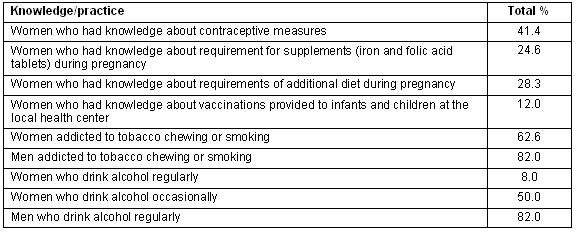
Discussion
The diet of all Oraon groups was deficient in all food groups. The cereal group comprised the most significant and least deficient food group. The major cereals consumed by the Oraons were rice and wheat. Other investigators have reported that diets of most tribal groups of India are based on rice or minor millets with the Mompas of Assam being one of the exceptions who also consumed wheat3. In the present study, the reason for the Oraons' high consumption of wheat and rice may be that these were supplied to them at subsidized prices through the public distribution system. However, they were also provided with pulses but their intake was only 33% to 40% of ICMR RDI. The relatively satisfactory intake of cereals but a deficit of pulses of the order of 36% to 42% in various tribes has been reported by other investigators5,10, indicating a deficiency of protein-rich items in the diet. The extent of deficiency is of a similar order of magnitude in the case of males, females and children. All Oraons were non-vegetarian but the consumption of non-vegetarian foods was limited to two or three times a month, usually on days when they were paid for their work.
It is often believed that dietary intakes of women and children are poorer than those of their adult male counterparts3,10. However, the present study does not indicate this; except for sugar and oil, intake of all food groups was more or similar in women, compared with men. Similar findings have been obtained in a study on Sugali tribals of Andhra Pradesh, where greater calorie and protein deficiency was found among the males, compared with females13. The energy deficit was similar for adult men, women and children, indicating that the midday meal replaced an equivalent amount of diet at home. School authorities confirmed that the supplement served as an incentive for the children to attend school.
Their intake of protective foods, such as milk, green leafy vegetables and fruit was very deficient. Other investigators have reported similar observations on other tribes5,10. It is noteworthy that these figures do not include vegetable and fruit obtained from their kitchen gardens and locally growing trees. As such, this data may represent an underestimation because it is not possible to obtain quantitative estimates of such consumption. Other investigators have discussed the importance of such inclusions in the diet of tribals3,5. Encouraging the cultivation of these plants will help abolish malnutrition. Because deficits of fruits and vegetables lead to deficiency of several nutrients such as calcium, iron, riboflavin and Vitamins A and C, clinical examination of the Kannikar tribal women has shown that anemia (90%), vitamin A deficiency (30%) and niacin deficiency (10%) were widely prevalent11. The diet of all Oraons (men, women and children) was found to provide only approximately half of the ICMR RDA17for energy. Others have reported similar findings3,6-7,12.
By general appearance, Oraon men and women seemed short statured. Data on mean centimeter height of women of several other tribes is: Gond 149.7, Chenchu 149.9, Jatapu 146.6, Savara 145.8, Koyadora 150.5, Kondareddy 148.5 and Yanadi 15022. Thus, the mean height of 144 cm of the Oraon women was less than that of the other tribals studied. In the absence of data regarding their genetics with regard to body build, it seems more appropriate to comment on their BMI. It is noteworthy that the mean BMI of both adult men and women fell in the normal range, despite energy intakes of the order of 52-53% of ICMR RDA. More women had a normal BMI than men, while there were more men than women in the 'mild CED' category. A higher prevalence of undernutrition in rural Indian adolescent boys compared with age-matched rural girls has also been reported18. The BMI of the Oraons compared with BMI of other tribals such as Gonds, Chenchu, Jatapu, Savara, Koyadora, Kondareddy and Yanadi, all of whom have a BMI between 17 and 1922.
The children had a much lower BMI, even though energy intakes of all three groups were similar at 52-53% of ICMR RDA. Despite low energy intakes, the mean BMI of Oraon men and women were not low, but that of children was grossly inadequate. Fifty-four percent of children were severely undernourished, 34% were moderately undernourished and only 3.3% were in the mild to normal category. Ideal BMI of this age group is 18.514. Other studies on many groups of tribal preschoolers have reported BMI between 12.8 and 14.6 while the parents had BMI between 17 and 1922. Catch-up growth, leading to normal BMI in adulthood is thus suggested. Children were enrolled in a midday meal program in their school, yet their energy intake was severely deficient, and of the same order as their parents, suggesting that the diet they would have received at home was replaced by that received at school. School authorities reported better attendance due to the midday meal program, but it has not resulted in increase in the energy intake of children to meet ICMR RDA, and the children continue to be as deficient as their parents.
The study also revealed potentially useful traditions followed by the Oraons. For example, they fermented their leftover rice, drank the liquid and ate the rice grains. Apart from preventing wastage, this can be expected to constitute a rich source of water-soluble vitamins. They drank black tea with salt but without milk and sugar in the morning before leaving for work. This may be healthy, as it would provide them isotonic fluids to sustain the water loss that will occur during their day in the tea garden. For separating the fat from pork, they added a tomato during cooking. The addition of acid food is known to hasten the cooking process of meat, a fact the Oraons must have been discovered by trial and error.
They prepared herbal tablets called ranoodava and used them to prepare an alcoholic drink with jaggery, and another drink called hadiya, used as a medicine. These may be sources of water-soluble vitamins, and the alcohol could be responsible for its efficacy against gastric problems. Consumption of haria, a home brewed rice-beer has been reported by other investigators in two rural blocks, Kanke and Namkum, of Ranchi district in Chotanagpur region of Bihar2. Another noteworthy practice was the use of mirchayia leaves for cleaning of the utensils before cooking. Further study is required with regard to the medicinal nature of these leaves, and the herbs used to make ranoodava.
Despite ICDS coverage, the Oraons' knowledge with regard to contraception, vaccinations, proper diet and supplements needed for successful pregnancy was severely deficient, indicating poor knowledge and awareness about health and nutrition. This assumes greater significance because the area was covered by the ICDS. At the health centre, contraception received more attention than other health related issues.
A large number of women consumed tobacco and alcohol, and there did not appear to be any social stigma against such consumption by women. Most of the men were addicted to tobacco chewing or smoking, and drank alcohol regularly after work in the evening, ostensibly to relieve physical strain and mental stress. Similar figures have been obtained for rural communities in other parts of India2,4. It is disturbing that the ICDS program in this area has not been successful at wide-spread dissemination of socially useful knowledge, nor has it achieved better compliance with useful practices. It has not been able to change the attitudes of this population to vaccinations, better diet and common addictions.
Conclusion
A remarkable finding of this study is that Oraon children were severely undernourished, as indicated by their low BMI. By contrast, the adult men and women had adequate BMI even though their energy intake as percentage of RDA was approximately the same as that of children. It is difficult to hypothesize why this was found because we do not have any longitudinal data. Further study is required, particularly following cohorts of children into adulthood to determine any adaptive mechanisms.
Rural health professionals who work with indigenous people, such as the Oraons, should be aware of both the qualitative and quantitative deficiencies often apparent in their community's diet. They should also be aware of the traditional practices concerned with methods of preparing food and use of local plants as medicines.
This tribal group, which is maintaining its identity in the midst of a relatively modern population, needs to be compared with groups belonging to the same tribe living in interior areas. It has been noted by Basu3 that many investigators have reported that tribals living in remote areas have a better overall status and eat a more balanced diet than tribals living in less remote, forest-free areas. This has been attributed to better utilization of available natural resources. The present study indicates the persistence of such practices, and suggests that a more in depth study is needed to evaluate them.
References
1. Indian Government. T 00-005: total population, population of scheduled castes and scheduled tribes and their proportions to the total population. (Online) 2001. Available: http://www.censusindia.net/t_00_005.html (Accessed 14 December 2005).
2. Singh AK, Rajyalakshmi C. Status of tribal women in India. Social Change 1993; 23(4): 3-18.
3. Basu SK. Health status of tribal women in India. Social Change 1993; 23(4): 19-39.
4. Singh AK, Sinha SK, Singh SN, Jayaswal M, Jabbi MK. The myth of the healthy tribal. Social Change 1987; 17(1): 3-23.
5. Tamilarasi MP, Ananthalakshmi A. Dietary practices of the Paliyar tribal group and the nutrient content of unconventional foods consumed. The Indian Journal of Nutrition and Dietetics 1991; 28: 297-301.
6. Gopaldas T. Nutritional status of selected tribes of western and central India. Proceedings of the Nutrition Society of India 1987; 33: 76-89.
7. Patel S. Ecology, ethnology and nutrition: a study of Khondh tribals and Tibetan refugees. Delhi: Mittal, 1985.
8. Almas A. Food habits, nutrition and health status of the Lanjia Saoras - a primitive tribe of Orissa. Proceedings of the Nutrition Society of India 1987; 33: 56-69.
9. Anon. Nutritional status of primitive tribes in Andaman and Nicobar Islands, National Institute of Nutrition, Annual Report 1990-1991. Hyderabad: NIN, 1991.
10. Kupputhai U, Mallika N. Nutritional status of adult women belonging to Khond, Gadaba and Porja tribes of Andhra Pradesh. The Indian Journal of Nutrition and Dietetics 1993; 30: 173-179.
11. Taneja PV, Saxena M. Nutritional anthropometry of Bhil women in Jhabua District of Madhya Pradesh. The Indian Journal of Nutrition and Dietetics 1998; 35: 98-102.
12. Sharma K. The Kondhs of Orissa: an anthropometric study. New Delhi: Concept, 1979.
13. Reddy PPYB, Rao AP. Dietary habits, food consumption and nutrient intake among the Sugali, a tribal population of Andhra Pradesh, India. Asia Pacific Journal of Clinical Nutrition 2000; 9: 12-17.
14. Shils ME, Olson JA, Shike M, Ross AC (Eds). Modern nutrition in health and disease. Energy and protein needs and anthropometric data. Baltimore: Williams and Wilkins, 1999; Appendices A2-C5.
15. Dwyer J. Dietary assessment. In: ME Shils, JA Olson, M Shike, AC Ross (Eds). Modern nutrition in health and disease. Baltimore: Williams and Wilkins, 1999; 942.
16. Gopalan C, Rama Sastri BV, Balasubramanian SC. Nutritive value of Indian foods. Hyderabad: Publ. National Institute of Nutrition, Indian Council of Medical Research, 1999.
17. National Institute of Nutrition. Dietary guidelines for Indians - a manual. Hyderabad: National Institute of Nutrition, 1998.
18. James WPT, Ferro-Luzzi A, Waterlow JC. Definition of chronic energy deficiency in adults. European Journal of Clinical Nutrition 1988; 42: 969.
19. Venkaiah K, Damayanti K, Nayak MU, Vijayaraghavan K. Diet and nutritional status of rural adolescents in India. European Journal of Clinical Nutrition 2002; 56: 1119-1125.
20. WHO. Report of WHO Expert Committee on Medical Assessment of Nutritional Status. WHO Technical Report Series no. 258. WHO: Geneva, 1963; 59.
21. Shakuntala M, Shadaksharaswamy M. Foods: facts and principles. New Delhi: New Age International, 1997; 408.
22. Hanumantha RD, Satyanarayana K. Nutritional status of certain tribal groups of Andhra Pradesh. Proceedings of the Nutrition Society of India 1987; 33: 70-75.
